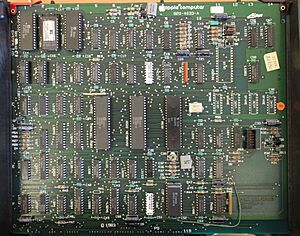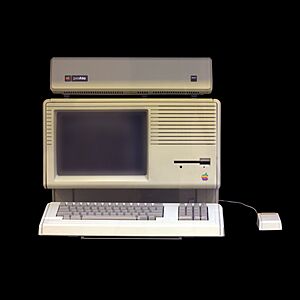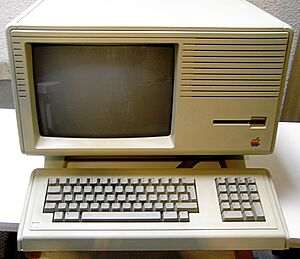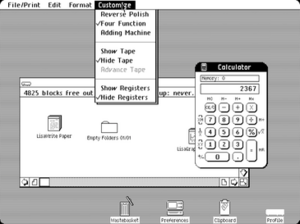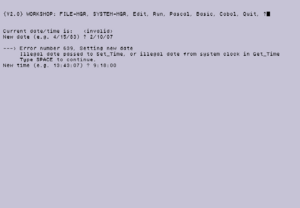Apple Lisa facts for kids
 |
|
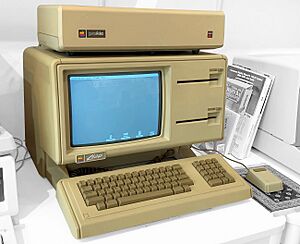
This Lisa has dual 5.25" "Twiggy" floppy drives and a 5 MB ProFile hard disk.
|
|
| Also known as | Locally Integrated Software Architecture |
|---|---|
| Developer | Apple Computer |
| Manufacturer | Apple Computer |
| Type | Personal computer |
| Release date | January 19, 1983 |
| Introductory price | US$9,995 (equivalent to $29,400 in 2022) |
| Discontinued | August 1, 1986 |
| Units sold | 10,000 |
| Operating system | Lisa OS, Xenix |
| CPU | Motorola 68000 @ 5 MHz |
| Memory | 1 MB RAM, 16 KB Boot ROM |
| Display | 12 in (30 cm) monochrome 720×364 |
| Input | Keyboard and mouse |
| Weight | 48 lb (22 kg) |
| Predecessor | Apple II Plus Apple III |
| Successor | Macintosh XL Macintosh |
The Lisa was an early personal computer made by Apple. It was sold from 1983 to 1986. Many people see it as the first computer for regular people that used a graphical user interface (GUI). This means you could use a mouse to click on pictures and icons, instead of typing commands.
In 1983, the Lisa was very expensive, costing about $9,995. This was a lot of money back then! It was mainly sold to businesses as a new option instead of much bigger and more expensive computers. Other computers with GUIs existed before Lisa, but they were not sold to the public. For example, Xerox PARC made the Alto workstation, but only for Xerox and its partners.
The Lisa project started in 1978. It went through many changes before it was released. Even with its advanced features, it didn't sell well. This was because of its high price, not enough software, and some unreliable floppy disk drives. Also, Apple was about to release the Macintosh, which was cheaper and faster. Only about 60,000 Lisa computers were sold in two years.
Even though Lisa wasn't a big sales success, it was very important for technology. It introduced many cool features that later appeared on the Macintosh and even on IBM PC compatible computers. These features included an operating system with memory protection and a way to work with documents easily. The Lisa's hardware was also more advanced than the first Macintosh. It could use a hard drive, had more random-access memory (RAM), and had expansion slots.
The Lisa's operating system and programs were very complex. This made the computer slow, especially its office programs. Also, the high price and lack of many different programs made it hard to sell. The popularity of the IBM PC and Apple's own cheaper Macintosh also hurt Lisa's sales.
In 1982, Steve Jobs, one of Apple's founders, was removed from the Lisa project. He then took over the Macintosh project. He decided to make the Macintosh a cheaper and simpler version of the Lisa. When the Macintosh came out in 1984, it quickly sold much better than the Lisa. Apple eventually rebranded the final Lisa model as the Macintosh XL.
Contents
History
How the Lisa was Developed
What's in a Name?
The original documents for the Lisa just called it "The Lisa." Apple later said that Lisa stood for "Locally Integrated Software Architecture." However, Steve Jobs's first daughter, born in 1978, was named Lisa. So, many people thought the computer was named after her. Some even believed the official name was made up later to fit the name "Lisa."
Andy Hertzfeld, one of the software developers, said that the official name was created in 1982. This happened after Apple's marketing team tried and failed to find new names for "Lisa" and "Macintosh." Privately, the developers joked that Lisa stood for "Lisa: Invented Stupid Acronym." Years later, Steve Jobs confirmed that the computer was indeed named after his daughter.
Research and Design
The Lisa project started in 1978. The goal was to create a more modern computer than the Apple II. A small team worked on it, and under John Couch's leadership, the project changed. It became a computer that used "windows and a mouse," like the final version.
At Xerox's Palo Alto Research Center (PARC), scientists had been working on new ways to organize computer screens. This led to the idea of the "desktop metaphor," where your computer screen looks like a desk. In 1979, Steve Jobs visited PARC. He was very excited by their revolutionary mouse-driven GUI on the Alto computer. Apple's team saw how a working GUI could be used. The Lisa team then worked hard to turn this idea into a product for everyone.
Developing the Lisa was a huge project for Apple. They reportedly spent over $50 million on it. More than 90 people worked on its design, plus many more on sales and marketing. Wayne Rosing was a key person in developing the computer's hardware. Bill Dresselhaus led the design of the computer's look and feel.
In 1982, after Steve Jobs left the Lisa project, he took over the Macintosh project. He decided to make the Macintosh a cheaper and easier-to-use version of the Lisa. He worked on it secretly, wanting to compete with the Lisa team.
Even before the Lisa was released, rumors about a "baby Lisa" called Macintosh were spreading. This new computer was said to be faster and cheaper.
Launch
The Lisa was launched on January 19, 1983. Its sales were quickly overshadowed by the Macintosh, which launched in January 1984. Apple released newer versions of the Lisa that fixed some problems and lowered the price a lot. However, it still couldn't sell as well as the much cheaper Mac. Many Lisa staff members moved to the Macintosh project. The very last version, the Lisa 2/10, was changed and sold as the Macintosh XL.
End of the Lisa
The Lisa was very expensive and its release was delayed. These reasons contributed to it being stopped. Even when it was repackaged and sold for less as the Lisa 2, it didn't succeed. In 1986, Apple stopped making the Lisa completely.
In 1987, a company called Sun Remarketing bought about 5,000 Macintosh XLs and updated them. In 1989, Apple got rid of about 2,700 unsold Lisa computers. They buried them in a landfill in Logan, Utah, to get a tax write-off. Some leftover Lisa computers and parts were available for a while after that.
Timeline of Lisa models

Overview
Hardware
The Lisa was first introduced on January 19, 1983. It was one of the first personal computers with a graphical user interface (GUI) sold to the public. It used a Motorola 68000 CPU running at 5 MHz. It came with 1 MB of RAM, which could be upgraded to 2 MB. Later versions even shipped with as little as 512 kilobytes. The CPU speed and model stayed the same throughout Lisa's life.
The computer's internal clock used a special battery pack. These batteries only lasted a few hours without main power. Over time, these battery packs could leak and damage the computer's circuit boards.
The Lisa had a built-in black-and-white monitor. It was 12 inches big and showed clear images with 720 by 364 pixels.
The Lisa could connect to several Apple printers. These included the Dot Matrix, Daisy Wheel, and ImageWriter printers. It could also use new color inkjet printers from Canon.
The first Lisa, called the Lisa 1, had two special 5.25-inch floppy disk drives. These were known as "Twiggy" drives. They could store a lot of data (about 871 kB each) but were not very reliable. They also used special diskettes that only worked with the Lisa.
The Lisa 1 also had some clever features for storing data. It could set aside "bad" areas on disks so they wouldn't be used. Important operating system information was also stored in multiple places. This helped recover data if something went wrong.
Lisa 2
The first major update, the Lisa 2, came out in January 1984. It was much cheaper, costing between $3,495 and $5,495. It got rid of the unreliable "Twiggy" floppy drives. Instead, it used a single, more common 3.5-inch 400K Sony microfloppy drive. The Lisa 2 could have as little as 512 KB of RAM.
The Lisa 2/5 was a Lisa 2 bundled with an external 5- or 10-megabyte hard drive. Apple even offered free upgrades for Lisa 1 owners to turn their computers into Lisa 2/5 models. This involved changing the floppy drives and updating some internal parts. The Lisa 2 also had a new front design with the Apple logo.
The Lisa 2/10 had a 10 MB internal hard drive. It came with 1 MB of RAM as standard.
To develop early Macintosh software, you actually needed a Lisa 2. There weren't many other companies making hardware for the Lisa. However, one company offered a memory board that could expand the Lisa to its maximum of 2 MB of memory.
Later in the Lisa's life, other companies offered hard drives and different floppy disk upgrades. Unlike the first Macintosh, the Lisa had expansion slots. This meant you could add more cards to it.
Macintosh XL
In January 1985, after the Macintosh was released, the Lisa 2/10 was renamed the Macintosh XL. It came with special hardware and software. This allowed it to run Macintosh programs and be sold as a high-end Macintosh computer. The price was lowered again to $4,000. Sales tripled, but Apple decided to stop making the Macintosh XL. This left a gap in Apple's high-end computer lineup until the Macintosh Plus came out in 1986.
Software
Lisa OS
The Lisa operating system had "protected memory." This meant that if one program crashed, it wouldn't crash the whole computer. This was a very advanced feature for its time. The Lisa's operating system also organized files into folders, just like modern computers. This was similar to earlier Xerox PARC computers. Unlike the first Macintosh, the Lisa was designed to work with a hard drive.
The Lisa had two main ways of working: the Lisa Office System and the Workshop. The Lisa Office System was the graphical environment for regular users. The Workshop was for programmers to create new software. It was mostly text-based. The Lisa Office System was later renamed "7/7." This name referred to the seven main programs it came with: LisaWrite (for writing), LisaCalc (for spreadsheets), LisaDraw (for drawing), LisaGraph (for charts), LisaProject (for managing projects), LisaList (for lists), and LisaTerminal (for connecting to other computers).
Apple's warranty for the Lisa said that its software would work exactly as promised. If it didn't, Apple would give users a full refund. These software problems, along with the high price, led to the Lisa's failure. NASA, however, bought Lisa machines mainly to use the LisaProject program.
In 2018, the Computer History Museum announced they would release the source code for Lisa OS. This means people can now see how the original software was made. For its 40th anniversary in 2023, the Lisa OS Software version 3.1's source code became available for everyone to study.
MacWorks
In April 1984, after the Macintosh came out, Apple introduced MacWorks. This was a software program that let the Lisa run Macintosh programs. MacWorks made the Lisa more appealing to buyers. However, early versions of MacWorks couldn't use the Lisa's hard drive for Macintosh programs. In January 1985, MacWorks was renamed MacWorks XL. It became the main program to turn the Lisa into the Macintosh XL.
Other Software
One big problem for the Lisa was that not many other companies made software for it. The first version of the Lisa Office System couldn't even be used to create new programs for itself. Programmers had to use a separate system called Lisa Workshop. For most of its life, the Lisa only had the seven main programs that Apple provided. Some companies did release other software, like UNIX System III and Microsoft Xenix (a type of Unix-like operating system).
Legacy
The Macintosh project, led by Steve Jobs, took many ideas from the Lisa's graphical interface. It also took many of the Lisa's staff. The Macintosh then became Apple's most important computer for many years. For example, the way files are shown in columns on modern Mac computers was first developed for the Lisa.
The Lisa also helped Apple develop its ideas about object-oriented programming. This later influenced the creation of the "Pink" system in 1988, which was an attempt to redesign the Macintosh operating system.
In 1989, Wayne Rosing, who worked on the Lisa, said that building the Lisa was hard work. He noted that the computer needed a hard drive and enough memory, and it was still slow. However, he also said that the way programs worked together on the Lisa was something Apple hadn't achieved again since.
See also
- People:
- Bill Atkinson
- Rich Page
- Brad Silverberg
- Technology:
- History of the graphical user interface
- Cut, copy, and paste
- Visi On
- GEMDOS (adaptation for Lisa 2/5)


